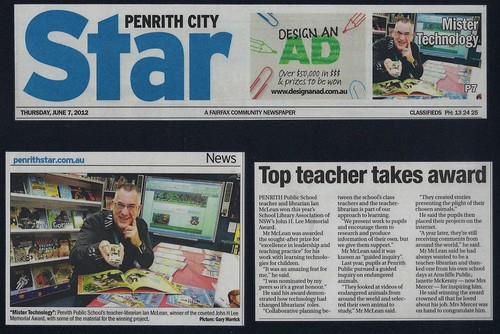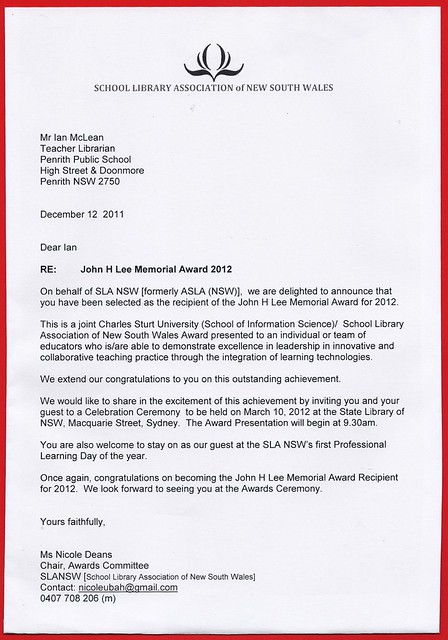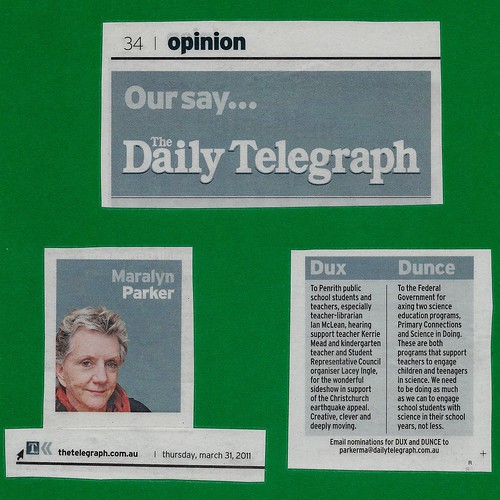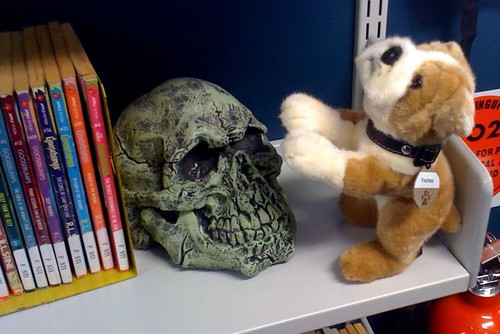Pic by Gary Warrick. Penrith City Star‘s coverage of my John H Lee Memorial Award for “excellence in leadership in innovative and collaborative teaching practice through the integration of learning technologies”. Presented jointly by School Library Association of NSW and Charles Sturt University. See the full article HERE.
Tag Archives: awards
John H Lee Memorial Award 2012
Dear Ian
RE: John H Lee Memorial Award 2012
On behalf of SLA NSW [formerly ASLA (NSW)], we are delighted to announce that you have been selected as the recipient of the John H Lee Memorial Award for 2012.
This is a joint Charles Sturt University (School of Information Science)/School Library Association of New South Wales Award presented to an individual or team of educators who is/are able to demonstrate excellence in leadership in innovative and collaborative teaching practice through the integration of learning technologies.
We extend our congratulations to you on this outstanding achievement…
Yours faithfully,
Ms Nicole Deans
Chair, Awards Committee
SLANSW [School Library Association of New South Wales]
The shortlist treasure hunt
The Children’s Book Council of Australia (CBCA) released its 2011 shortlist of nominated children’s book titles for Book Week last Tuesday, and the mad scramble – to make sure school library collections have the books – has begun in earnest.
When the stores say a shortlisted title is “not available”, that’s because it has already sold out of its initial print-run everywhere (ie. the warehouses are often empty long before the nominations come out, or they are cleaned out the day the shortlist is announced), and the publisher is now attempting to get a second printing done in time for Book Week. That attempt is usually successful, at least for the city stores in most states. Sadly, books that don’t make the shortlist often never get a second hardcover printing. That precious nomination is often their key to longevity. Publishers are very frugal and only very strong sellers and award nominees get a second bite at the market. Paperback versions of nominated hardcovers often don’t get scheduled until the approaching Christmas season, too late for Term 3 Book Week celebrations.
I have permission from my Principal to round up the titles in whichever bookshops I happen find them in, hopefully in ones that offer us a decent discount. I haven’t bought any books for the library since last Easter (except the 2010 shortlist) because of our BER rebuilding, so my 2011 shortlist shelves were totally bare. I’ve been treasure hunting shops since last Tuesday when the list came out – and I have actually found almost everything (including most of the Crichton Award nominees for first time illustrators). Often it’s the lone copy on a shelf I find, but a surprising number of the titles have been in reasonable supply this year. I resist just back-ordering the whole list from one seller at this time of year, because inevitably I see older, first printing copies in forgotten corners all over Sydney, when I could be using them with the students, but the shops also dislike it when you keep canceling books from the order. This time of year drives the booksellers crazy, and it also seems unfair to think of all those wonderful books that just missed out making it to the Notables list, since they are probably destined to be a distant memory.
So there’s no easy answer. I happen to enjoy the treasure hunt, and am usually very successful. Several of my favourite haunts see me walk in the door and they say, “Ah, we know what you’re looking for!”, even if it’s been a year between visits.
The theme this year is “One World, Many Stories”, and is neatly served by this cute song on Youtube.
Dux
Wow! Thanks Maralyn Parker and our mystery nominator!
31 March 2011: “To Penrith Public School students and teachers, especially teacher-librarian Ian McLean, hearing support teacher Kerrie Mead and kindergarten teacher and Student Representative Council organiser Lacey Ingle, for the wonderful slideshow in support of the Christchurch earthquake appeal. Creative, clever and deeply moving.”
Note that the article says “sideshow” (sic).
All Black Day: Christchurch earthquake appeal, 2011
Still building the online profile
Wow! This professional learning blog, “Booked Inn”, has been nominated on a shortlist for “Best Librarian/Library Edublog 2010” in The Edublog Awards. Voting (please click HERE) doesn’t seem too complicated; I would love your support. Many thanks in advance! It’s such a buzz to make the shortlist. (Looks like all that work on Build Your Online Profile with Tristan Bancks, at the Sydney Writers’ Centre in Term 3, is really paying off.)

Also, as an update to the work done by Kindergarten students this term, the first of our Photo Peach slideshows for the “Travelling Fearless Project” garnered 726 views (and 40 comments, including Sarah Davis, the illustrator of “Fearless”). Simply astounding! And it gets better: I Just received an automated email, via Photo Peach, that someone had made my page a favourite of theirs. I was curious, so tracked back and ended up on the main search page. It seems that, of Photo Peach’s 42 pages of “Recently Popular” slideshows, “Travelling Fearless” is on Page 1 (one of 15 image links sitting there, gathering even more views as I type). And the sequel, Farewell Fearless!, is on Page 3!
Bear and Chook by the sea: nominated!
Congratulations to author Lisa Shanahan and illustrator Emma Quay!
Last week the news broke that their picture book, “Bear and Chook by the sea”, has been shortlisted in the annual CBCA awards, in the Early Childhood category. The winners of this prestigious competition are announced in Book Week (in Term 3).
The students at my school remember the book’s creators and characters so well from last year’s Bear and Chook books rap and wish them all the best. Meanwhile, I understand that Bear and Chook themselves have been taking separate vacations:

Bear at Sea World, on the Gold Coast
and…
Library Blog Awards
This blog has been nominated for a Library Blog Award by readers of “Booked Inn”. (Thank you, whoever you are!)
The Library Blog Awards awards aim to publicise “the most interesting, entertaining and provocative library blogs out there”. For more information on these awards, please go to www.salempress.com/blogs.
Wish me luck!
Making your vote count
Book Week is fast approaching!
Over on the OZTL_Net listserv, a teacher-librarian asked for ideas for getting students more involved with the annual Children’s Book Council of Australia (CBCA) awards. While there are other, student-voted, literary awards out there (eg. KOALA – Kids’ Own Australian Literature Awards), the CBCA “books of the year” are selected by adult judges, so sometimes the students can feel left out of the judging procedure.
It’s not difficult to lead discussion with students as to what are valuable criteria for judging children’s literature. Some categories are easier for students to judge, because they are within the intended audience of certain books. With guidance, Year 6 students can still make incisive observations about what makes a good picture book for younger students. You can also deconstruct the actual rules used by the CBCA judges.
This is the third year I’ve organised CBCA voting with students this way:
* K-2 (Early Stage 1; Stage 1) are judging Picture Books and Early Childhood Books
* Years 3-4 (Stage 2) are judging Picture Books and Information Books
* Years 5-6 (Stage 3) are judging Picture Books and Novels for Younger Readers.
I supply two empty bar graph grids per student, with the titles written at the base of each column. As we read and appreciate the books, in any order, they give points out of ten and colour their graphs. When all six bars of the graph are filled in, the highest columns are declared the winners and the students record their predictions. They find it very tricky if they’ve voted “ten out of ten” for two or more titles in a category. When Book Week arrives we fill in the actual winners beside their own choices.
At my previous schools, we’ve usually done a show-of-hands voting on a class column graph, but individual voting seems to enthuse the students even more. There’s usually a lot of clapping and cheering when I announce the winners at the school assembly in Book Week.
I recall really impressing one principal, in my first year as a teacher-librarian. She said, “I’ve never heard these children cheer for a book before…!” – and a few days later there was lots more money in my library budget.
CBCA announcement looms
My students are so excited. In recent weeks, I’ve worked them into a bit of a frenzy over which books will win the gold and silver medals. Not the Beijing Olympics medals, but the Children’s Book Council of Australia Awards, which are announced at noon tomorrow.
Like last year, each class has been creating a column graph of their preferences. Everyone’s voting in the picture book category, plus Stage 1 is doing Early Childhood, Stage 2 information books and Stage 3 the novels. This helps them to invest a little more into the announcement of winners.
Picture Book of the Year? Even though the graphic novel, “Requiem for a beast” by Matt Ottley, is aimed at a Stage 6 (Years 11 and 12) readership, I bought a copy for myself and took it into school to expose the students to the book’s unique qualities: they were fascinated how the style changed from picture book, to chapter book, to storyboard, to almost-motion picture widescreen, to comic book, to scrapbook, and back to chapter book. Many of the students had the gut feeling that it may well win Picture Book of the Year. “Dust” and “The Peasant Prince” have also been well-received and, for a few classes, I ended up presenting these books in the same lesson and the students enjoyed their similarities and differences. “The island” is as confronting and challenging as “Dust”, and it will be interesting to see which books end up winning.
We ran out of time to do much justice to the longer novels in the Books for Younger Readers category, but an unexpected favourite (of both theirs and mine) has been “Sixth grade style queen (not!)” by Sherryl Clark. Many students picked up on its similarity in style to the work of poet Stephen Herrick, who visited our school last year for National Literacy & Numeracy Week. The senior students are keen on Emily Rodda’s work, especially since she visited a few years ago and told the students she was “happily retired” but then we discovered she’d secretly been writing “The key to Rondo”, much to the surprise of even her agent and publisher! Writing without a deadline was a special treat she’d given herself. “The Shaggy Gully Times” is also a bit of a dark horse, but I’ve had to work with the students to appreciate the cleverness of its humour and wordplay; luckily the current book rap is helping with this.
It’s always hard to pick the Books for Early Childhood category! As a teacher reading to groups of students, I think I had the most fun with “Cat” by Mike Dumbleton & Craig Smith. As the owner of two ginger cats in my life, I could relate to every page! (I actually have a photograph of Dugil sprawled over the mat where I was trying to mark papers, and an earlier shot of Meggsie stealing the heater from both my younger brother and the family dog! This will be an impossible category to pick; all six entries are so worthy.
Information book category? My prediction (from this time last year!) has always been “Parsley Rabbit’s book about books” by Frances Watts & David Legge. Oh, how i wish I’d written this book. It says everything ‘ve ever needed to say about “parts of a book”. “Parsley Rabbit” turned up in my local bookshop the week before Book Week last year, and was my special treat for each class. It’s remained a much-coveted, much-read – and much-requested – book in our school library. Most of the students are expecting this book to win. And so am I. We also have a soft spot for several others, including “The Antarctica book: life in the freezer” and “Australia’s deadly and dangerous animals”, which seem to be very accessible books for primary students.
Noon on Friday can’t come soon enough…
Shelving decisions
Every year since 1999, the NSW DET team gathers the reviews of the annual Children’s Book Council of Australia shortlisted books onto a web page. It’s a topic I find quite nostalgic, since when I worked at Scan, as editor, it was part of my job to prepare the annotations and reviews for uploading, and to do all the cross referencing.
2008 isn’t up yet, but most of the nominated books have already been reviewed in past Scans. Resources are reviewed by experienced NSW teachers, teacher librarians and DET (Department of Education and Training) curriculum specialists to a clear set of criteria, and stage levels, perspectives and curriculum links are always recommended. The May issue of Scan (vol 27 no 2) arrived in schools just this week, and the latest annual annotated list of CBCA shortlisted books (directing readers to various past issues containing the reviews) is on pp 44-45.
I very rarely get the “Books for Older Readers”, such as this year’s Love like water by Meme McDonald, for the K-6 school library since the CBCA usually specifies “for mature readers” for this section when the shortlists are announced. Love like water was reviewed in Scan (vol 26 no 3) and it was recommended only for Stage 6 (Years 11 and 12).
Scan suggests Matt Ottley’s Requiem for a beast for Stage 5 and 6 (Years 9-12). I must admit I’m quite intrigued to see it; I love Matt’s past work, and this book features a music CD to accompany the strong images!
I have picked up the information book, Girl stuff (not getting a print review in Scan until vol 27 no 3), but I’ve housed it in our Reference section and will promote it to the Stage 3 (Years 5 and 6) students by way of their class teachers. Likewise, I placed the haunting picture book Dust in my Reference section, since I wasn’t sure that parents would appreciate young students taking it home.
From the Crichton Award new illustrators’ category, I made sure that Ock Von Fiend went into Fiction, not Easy Fiction. I recall several people questioning its inclusion in Australian Standing Orders last year and, again, it’s a beautiful picture book which needs to be placed with appropriate audiences.






